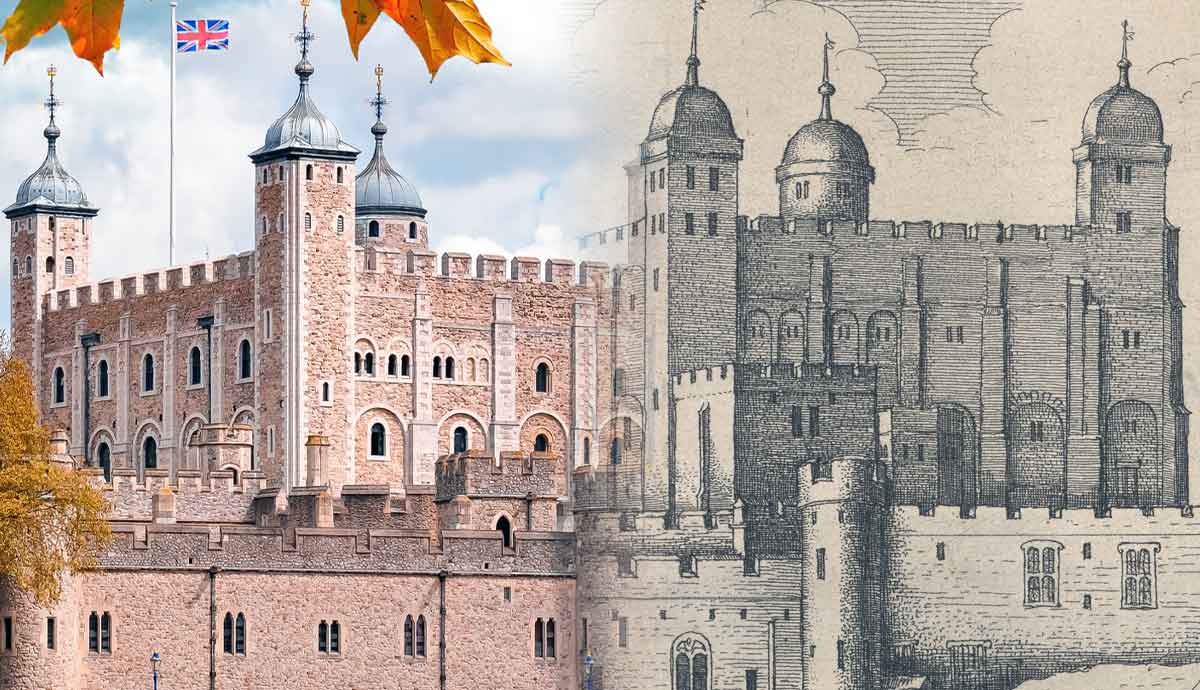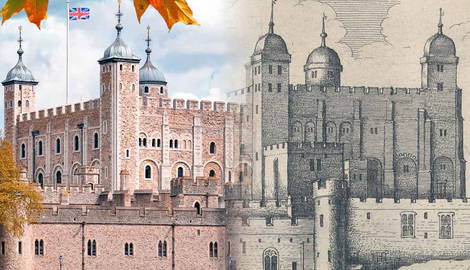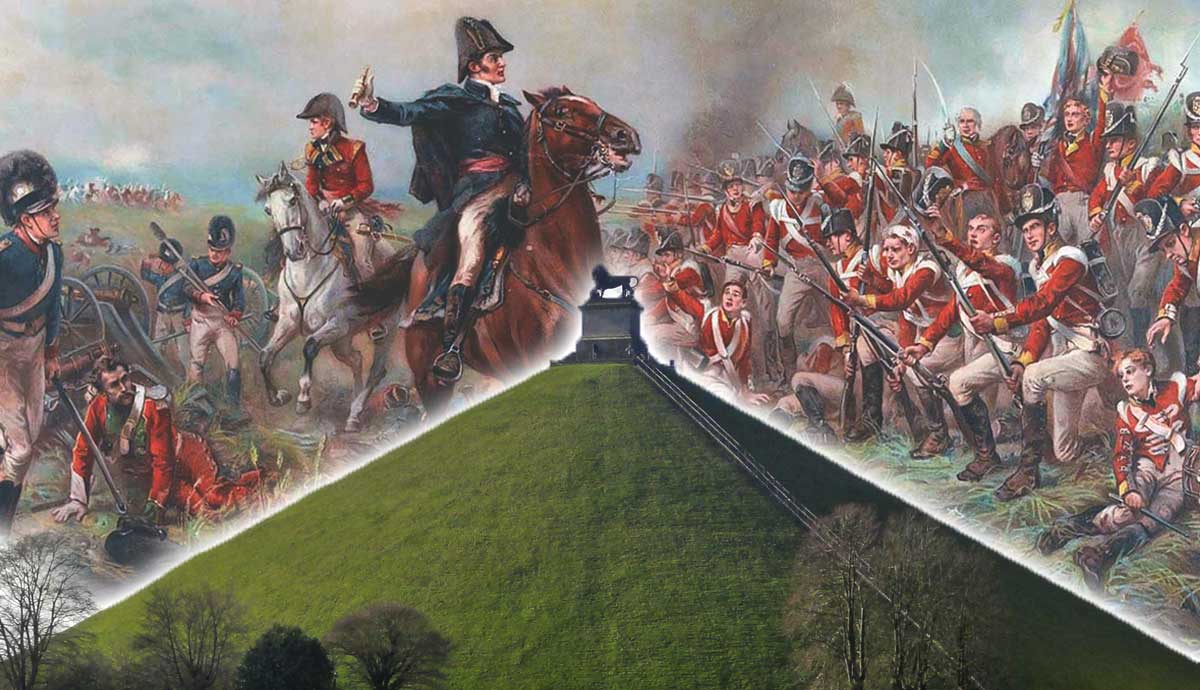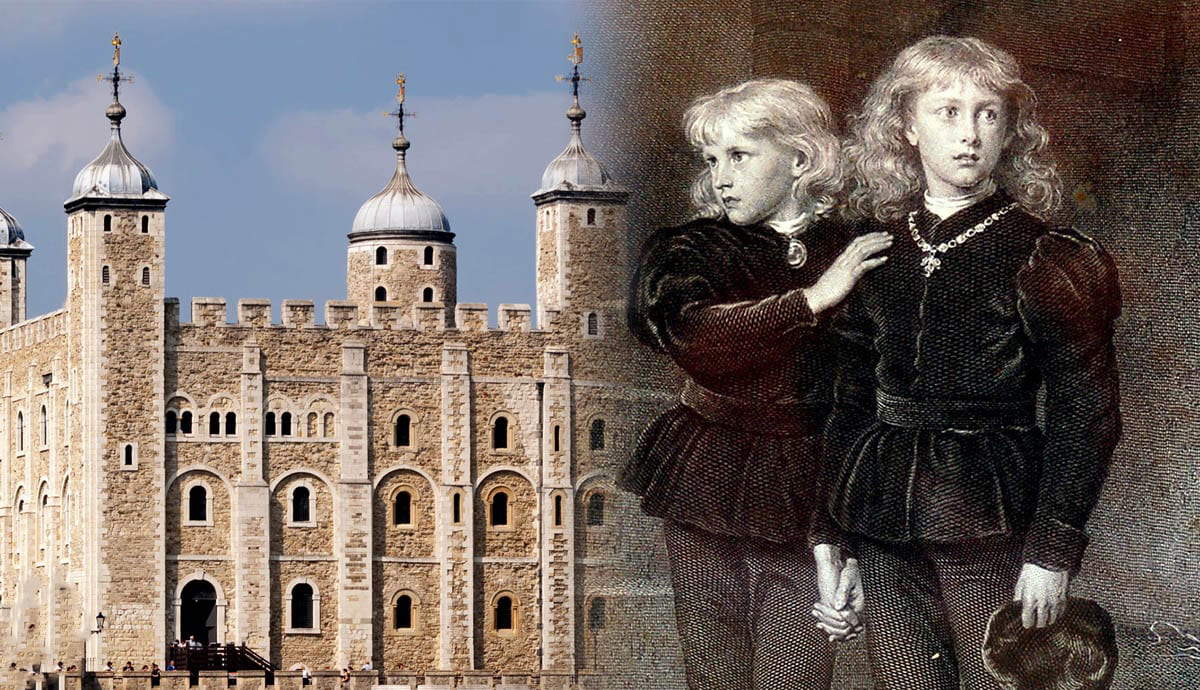
The Tower of London has a long history, beginning with William the Conqueror in 1066, undergoing significant changes throughout various reigns. Its history continues into the present day. The architecture of the Tower of London has its own story, as the figures of English History interacted with it and changed it to fit their needs as monarchs throughout the years.
The Tower of London and William the Conqueror

The Tower of London was born as a result of the Norman invasion led by William the Conqueror. Edward the Confessor offered him the role of succession, and Queen Edith’s father, Harold Godwinson, had sworn to support William’s claim to the throne when the time came. When Edward the Confessor died in January of 1066, and Harold II promptly took the throne for himself, William raised arms to take what had been promised to him. After the Battle of Hastings, through which William the Conqueror would take power over England, the local population was angry about a Frenchman ruling a mostly Anglo-Saxon population.
He was crowned on December 25th, 1066, as a show of Christian faith, but the coronation did not go well. The ceremony was held in Westminster Abbey, where a large crowd was outside. The crowd erupted into cheers when asked if they would accept William as their King. It had been a year without a crowned King, which held the kingdom in political uncertainty. They were ready for a King. However, due to the language barrier, the cheers were misinterpreted by William’s guards. The guards set fire to buildings to disperse the crowd. Riots broke out, causing true hostility. William finished his coronation alone and trembling.
The King ordered a fortified castle to be built near the Thames River. Its purpose was to protect his rule from enemies and angry Londoners. Construction finished in 1097, under the rule of William the Conqueror’s son and successor, William II. Three years later, in 1100, the castle held its first state prisoner, marking the beginning of a long history as a notorious prison.
Richard the Lionheart & William de Longchamp

In 1190, King Richard I, also known as Richard the Lionheart, left England for the Crusades. Upon leaving, he chose William de Longchamp, Bishop of Ely, as his regent. He would live at the Tower of London until the King returned. Longchamp took advantage of the power he held while the King was away, seizing land from the city around the Tower of London, including a hospital, and expanding the fortress. New towers included the Wardrobe Tower and Bell Tower.
The monarch stored their clothing, armor, and other equipment in the Wardrobe Tower. Today, the Wardrobe Tower barely exists—it’s a crumbling tower of stone situated near the White Tower. A small sign marks it and can be easy to miss, though it once would have been plush with expensive fabrics and royal attire inside.
The Bell Tower was not completed during Richard I’s reign, finishing in 1210. It was initially used for defense, with tall, skinny windows for archers to safely shoot their arrows, while lowering the chance of getting hit themselves. It was once called the Bowyer’s Tower, named after the men who made the longbows. The Bell Tower became a more common name due to the belfry on the top. The bell would be rung to warn of invasion, and the portcullis would be dropped. The drawbridge would be raised, and archers would be put into position for defense. Later, the bell tower would be used as a holding cell for notable prisoners, such as the future Queen Elizabeth I, Sir Thomas More, and Lady Jane Grey. Later, it was used to store gunpowder. Today, it’s well-known for its carved graffiti.
The locals were understandably upset about William de Longchamp seizing land for the Tower of London. Prince John, the youngest son of Henry II and brother of Richard the Lionheart, placed the fortress under siege in opposition to Longchamp. Despite the extensive additions, it only took three days for Longchamp to surrender due to a lack of necessary provisions.
John Lackland

Prince John, also known as John Lackland, was the younger brother to Richard the Lionheart and their father’s youngest son. He grew up understanding that he would not inherit land, hence his nickname. When his older brothers rebelled in 1172, he became his father’s favorite son and was given land and favor. Richard the Lionheart began to worry that John might be given the role of succession. Richard returned from his travels and made peace with his father to ensure he kept his place in the line of succession. Nonetheless, John would become king after his older brother’s death and would be disliked for cruelty and oppressive taxes, immortalized in the tale of Robin Hood.
When Prince John became King in 1199, he founded a royal menagerie at the Tower of London, which would be filled with exotic animals over the next seven centuries. In 1235, Henry III, John’s son and successor, received three leopards. In reality, these were three lions, which were put into his Plantagenet crest design. It became an essential symbol for England. In 1252, the King of Norway gifted Henry III a polar bear. They fed the bear by tying a rope around its neck and allowing it to swim the Thames to hunt fish. When it was not hunting, the bear was kept muzzled and chained inside.
In 1255, the King received an elephant from the King of France, but England in the 13th century did not have proper knowledge of exotic animal care. In 1264, the menagerie moved to the Lion Tower. People began to pay for entry in 1360, starting a tradition of tourism at the Tower of London that proved extremely dangerous for everyone involved. Visitors, animal caretakers, soldiers, and other animals were seriously injured or killed throughout the centuries.

Public interest eventually declined. In 1822, the menagerie was in a deep state of decline, and the headkeeper, Alfred Cops, made it his mission to bring it back to life by adding various animals to the fortress’s collection. It worked, becoming a popular tourist attraction once again. However, concerns for the animals’ welfare began to be raised, and the Duke of Wellington, the constable of the Tower, believed that the animals were creating a nuisance and subtracting from the fortress’s value for military purposes. In 1835, the Duke of Wellington had the animals removed from the Tower of London and placed elsewhere. This was the beginning of the famous London Zoo in Regent Park. Today, the animals at the Tower of London are commemorated with metal wire sculptures by Kendra Haste, located near the modern entrance. The Lion Tower, where they were kept, was torn down shortly after.
Henry III & Edward I

Henry III admired the Tower of London and wanted to contribute to it. He hired an architect named Henry de Reyns to build more towers. The list includes the towers Wakefield, Lanthorn, Byward, Middle, Salt, Flint, Martin, Brick, Constable, Broad Arrow, Garden, and Bowyer. Wakefield Tower was built to be private quarters for the King. Meanwhile, Lanthorn Tower was the Queen’s private quarters. Though the Tower of London was undoubtedly known as a notorious prison by now, it still accommodated the royal family as a royal residence.
Henry III’s son and successor, Edward I, also known as Longshanks, continued his father’s construction efforts at the Tower of London. He added St. Thomas’s Tower, the Well Tower, the Beauchamp Tower, and a small structure called the Develin Tower. The moat was also completed under his reign, strengthening the castle’s defense. In 1303, the Crown Jewels were moved from Westminster Abbey to the Tower of London for safekeeping, where they remain to this day.
St. Thomas’s Tower is currently set up to look at how it would have been when Longshanks lived, nicknamed for his towering height, which caused him to need an especially large bed. This bed is recreated by the Historic Royal Palaces at the Tower of London for visitors to see.
Edward III & Richard II

Edward III would see the Cradle Tower built, but he would have bigger problems on his hands than extending the castle and its various towers. The Black Death hit England, and London’s population was nearly halved in a short amount of time. The moats around the Tower of London were drained to help prevent the spreading of disease, as there were plague pits of deceased plague victims situated around the Tower of London.
It was also during Edward III’s reign that the name The White Tower caught on as they began painting the castle a stark white. The reason Edward decided to paint the castle is unknown, but some historians theorize that it was simply an aesthetic choice to make the building look nicer according to European styles at the time. He also added decorations to the Chapel of St. John the Evangelist, located in the White Tower. Decorations included new stained glass windows, paintings, and some sculptures.
His grandson and successor, Richard II, would be the only English monarch to see the Tower of London breached. In 1381, angry peasants revolted against the climbing taxes as they struggled to afford to live. Once inside the Tower of London, they dragged Simon Sudbury, Archbishop of Canterbury, out onto Tower Hill and violently beheaded him and a few others whom they believed were responsible for the oppressive taxes.
Henry VIII

During Henry VIII’s reign, the Tower of London underwent many changes as well. Guns were fairly new inventions in early-16th-century England, but the King had them incorporated into the Tower of London to keep up with new military innovations. However, the roof of the White Tower needed to be strengthened before they could add cannons to the top.
Henry VIII had a royal wedding to plan and wanted the Tower of London to be newly renovated for his new Queen. He ordered Thomas Cromwell to be in charge of revamping the structures, including redecorating the Great Hall. In 1533, Anne Boleyn began her coronation procession to Westminster Abbey out of the newly built Queen’s House, which were special apartments constructed by Henry VIII for his new Queen. He also changed the White Tower, adding metal onion-shaped cupolas with weathervanes for the event, which are still visible today. Only a few years later, in 1536, Anne Boleyn would once again find herself at the Tower of London, this time as a prisoner.

The Chapel Royal of St. Peter ad Vincula burned down and was rebuilt in 1512, which is the current building that remains today. It is unclear when the original chapel was built, though we know it was already there by 1100. Some believe it may have been a parish church for locals before the Tower of London grew out around it, though evidence is scarce.
The Chapel Royal of St. Peter ad Vincula, which would have been only about twenty years old at the time due to the fire in 1512, is now the resting place for important historical figures, like Anne Boleyn, Catherine Howard, and Lady Jane Grey. Anne Boleyn was beheaded on May 19th, 1536, by a French swordsman, aged 29-35, on the orders of her husband, the King. Amidst the chaos of the trial and imprisonment, her ladies had forgotten to secure a coffin for her and used an arrow chest instead. They refused to let a man touch her body and took it upon themselves to carry her out of respect.
Catherine Howard was beheaded by ax on February 13th, 1542, aged 18-20, on the orders of her husband, the King. Her body is lost, as it is believed to have been covered in Quicklime to speed up decomposition in an attempt to eliminate her entirely from the earth. Lady Jane Grey was beheaded by ax on February 12th, 1554, aged 17, on the reluctant orders of her cousin, Mary I. She had been wrapped up in her family’s plots to put her on the throne, and there was fear of an uprising against Mary I, requiring Lady Jane Grey to no longer be an option for the throne.
The Mint

After the death of Elizabeth I, the Tower of London became a less popular residence for the royal family. Though it never fell into disuse, the following royal families became much less interested in staying at their Tower of London residences, let alone spending the money to improve or expand. During the Commonwealth of the 17th century, the Crown Jewels were taken apart and sold, though they were able to get most of them back after the monarchy had been restored.
The Tower had held the Mint since the 13th century when Edward I moved it to the tower for safety reasons. It was hazardous work. Poisonous gasses filled the room. It would have been unbearably hot from the melting metals, and losing a finger or eye was common as they hammered coins into shape. Punishments were harsh, too. The employees were instructed to stay away from other employees at the Tower of London and were closely watched by guards as they came and went. A counterfeiter or thief would have their right hand cut off after the first offense. After the second offense, the punishment was genital mutilation, such as castration. In 1810, the Mint was moved from inside the Tower to a new building on Tower Hill. Today, the Mint has been moved to Wales.
Queen Victoria’s Use of the Tower of London

Queen Victoria ordered the Tower of London to be re-medievalized in 1851, to open up the fortress to the public for tourism. The Bloody Tower (previously the Garden Tower), White Tower, St. Thomas’s Tower, and the Salt Tower were all restored to appear more medieval. The first guidebook was written and a ticket office was built outside of the entrance.
In 1876, the Chapel Royal St. Peter ad Vincula underwent restoration, including the altar floor, under which Anne Boleyn, Catherine Howard, and Lady Jane Grey were buried. The bones were exhumed and briefly studied before being returned to their graves after restoration. World War I and II also affected the Tower of London. During World War I, a German bomb hit the moat, allowing experts in the 1930s to excavate what would have been the menagerie, where they found countless animal bones and skulls from the animals who had lived there for centuries.
In 1967, a new underground structure was built to house the Crown Jewels. However, the small size of the structure could not accommodate the daily number of visitors, which numbered almost 15,000 in just a single day. Instead, they were moved to their current location in the Jewel House. The Tower of London has a long history of architectural changes, transforming throughout the centuries to fit the needs of the reigning monarch. Today, the Tower of London is open to the public, where the ancient buildings allow the present to meet the past.










